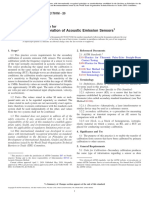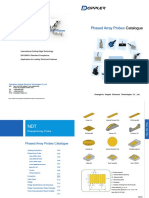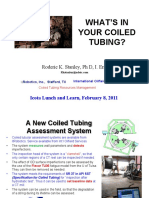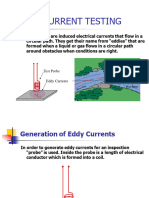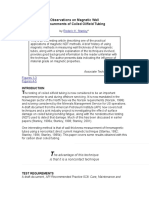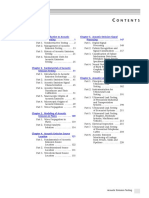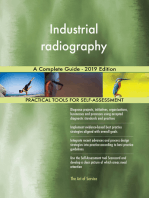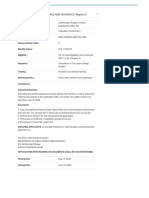Acoustic Emission Testing of High Strength Steel LPG Spherical Tanks
Acoustic Emission Testing of High Strength Steel LPG Spherical Tanks
Uploaded by
David RodriguesCopyright:
Available Formats
Acoustic Emission Testing of High Strength Steel LPG Spherical Tanks
Acoustic Emission Testing of High Strength Steel LPG Spherical Tanks
Uploaded by
David RodriguesOriginal Title
Copyright
Available Formats
Share this document
Did you find this document useful?
Is this content inappropriate?
Copyright:
Available Formats
Acoustic Emission Testing of High Strength Steel LPG Spherical Tanks
Acoustic Emission Testing of High Strength Steel LPG Spherical Tanks
Uploaded by
David RodriguesCopyright:
Available Formats
Proceedings of the ASME 2013 Pressure Vessels and Piping Conference
PVP2013
July 14-18, 2013, Paris, France
PVP2013-97333
ACOUSTIC EMISSION TESTING OF HIGH STRENGTH STEEL LPG SPHERICAL TANKS
Jun Jiang
Nanjing Boiler & Pressure Vessel Supervision and Inspection Institute
Nanjing City, Jiangsu Province, China
Rong Yi
Nanjing Boiler & Pressure Vessel Supervision and Inspection Institute
Nanjing City, Jiangsu Province, China
Lili Que
Nanjing Boiler & Pressure Vessel Supervision and Inspection Institute
Nanjing City, Jiangsu Province, China
defects of the pressure vessel generate acoustic
ABSTRACT emission signals, and then collect these signals
We use acoustic emission technique for the using acoustic emission instruments. This
detecting of 1000m3 LPG spherical tank. The overall technology can quickly identify the location of
moitoring and local monitoring, as well as a the sound emitting source and make re-inspection
combination of the two methods are applied. By and assessment for these acoustic emission
lowering the threshold value, detection sensitivity is sources, so as to shorten the maintenance cycle
improved. 23 effective acoustic emission sources are and reduce the economic costs.
discovered, in which 21 crack defects are retest. In this work, we have maken acoustic
emission testing for a 1000m3 LPG (liquefied
INTRODUCTION petroleum gas) spherical tank, using the
The pressure vessels are widely used in all combination of the overall monitoring and local
walks of life. Once the accidents of leakage or monitoring methods. It is found that there are 23
rupture of the pressure vessels happen, it may effective acoustic emission sources and 21 crack
lead to fire, explosion and poisoning, causing defects exist after re-inspection
serious damages to the properties and lives. In
order to increase the company's core THE GENERAL SITUATION OF THE
competitiveness, the pressure equipments must be SPHERICAL TANK
on long-cycle operation, and the maintenance and This LPG spherical tank belongs to a
inspection costs must be minimized. Petrochemical Companywith the number of G909.
The acoustic emission can be detected in the Its design pressure is 1.8MPa + (static pressure).
working condition of the pressure vessels. By Its design temperature is -10 to 50 ° C. The
changing the parameters of the process operation maximum operating pressure is 1.6MPa. The
of the pressure vessel, it can make the active operating temperature is room temperature. Its
1 Copyright © 2013 by ASME
Downloaded From: http://proceedings.asmedigitalcollection.asme.org/ on 02/17/2016 Terms of Use: http://www.asme.org/about-asme/terms-of-use
diameter is 12410mm and the volume is 1000m3. local monitoring is shown in Fig.2.
The medium is liquefied petroleum gas. The main Two pressure cycles are applied for the
material is SPV50Q, with the nominal wall pressure test program of the acoustic emission
thickness of 34mm. The spherical tank was testing, in which the clean water is filled to
designed and manufactured by the CBI, Ltd., increase the pressure. The whole process is in
Japan, and was built by a local construction accordance with the requirements of
company. This tank was put into use in November GB/T18182-2000 and combined with the actual
1987 and during the inspection process in April situation of the tank at the scene.
2001, it was found that there were a lot of cracks
on the inner surface of the butt weld fusion line. LOADING THE PROGRAM
Through the hydrogen elimination processing, On-site noise measurement has been
welding and the overall treatment of stress-relief, conducted prior to the testing, with a signal of
this tank has been used ever since after passing less than 52dB. Because the result of attenuation
the hydrostatic test. measurement is more than the 16MnR material,
the threshold value is set to 40 dB in order to
THE DETECTION SCHEME ensure the detection accuracy.
Two instruments namely the SWAES-35 and The location calibration of the 44
SWAES-50 multi-channel digitized acoustic representative triangle positioning arrays and the
emission detection analyzers produced by Beijing 32 representative linear positioning arrays all
Shenghua Technology Co., Ltd. are used. The provide good positioning results.
WAE2002 source localization testing analysis
software is applied. The sensors are SR150 ANALYSIS ON THE DETECTION DATA
resonant sensors (with preamplifier and can be We mainly apply some commonly used
calibrated by self-excitation), with the center parameter analysis methods to analyze the
frequency of 150kHZ, the main amplifier gain of detection data. Since the threshold value is lower,
40dB and the bandpass frequency of 20-120kHZ. the effective sound source signals and the noise
46 channels of SWAES-50 acoustic emission signals are mixed, we will distinguish them by the
instrument are used to make overall monitoring following methods.
on the spherical tank, in which the spherical The waveform judgment: to distinguish the
positioning is applied. Besides, 32 channels of burst signals, the continuous signals and the
SWAES-35 acoustic emission instrument are used sensors’ self-excitation signals. In this detection,
to monitor the up and down girths of the spherical the main objective is to detect the cracks of the
tank, in which the linear positioning is applied. spherical tank, thus the burst signals are the main.
The overall monitoring: a total of 46 probes The signal recognition before the pressure
(five layers in total: 6 probes on the first and boost and during the two times depressurization
fourth layers, 10 probes on the second and five processes: if a signal source occurs frequently in
layers, 12 probes on the third layer and 1 probe at the entire inspection process, the signal is not
the top and bottom center of the spherical tank necessarily a signal generated by the defect. We
respectively) are arranged in a triangular array. should focus on checking the location of the site
The specific arrangement of the probes on the on the spherical tank, and analyze that whether
tank are shown in Fig. 1. the signal is generated by the vibration, collision
The local monitoring: a total of 32 probes are and friction of the scaffolding, in and out of the
arranged circumferentially (two layers in total: media, sensor self-excitation of the sensors, etc.
located around the upper and lower large girths). For the vicinity of the weld and the stress
The detailed arrangement of the probes of the concentration areas, even if the pressure boost
2 Copyright © 2013 by ASME
Downloaded From: http://proceedings.asmedigitalcollection.asme.org/ on 02/17/2016 Terms of Use: http://www.asme.org/about-asme/terms-of-use
stage is inactive, we also consider it as effective use the acoustic emission technique to achieve the
acoustic emission source. in service inspection for spherical tanks.
1. The combination of the overall monitoring and
RESULTS AND DISCUSSION local monitoring methods can confirm and
During the online overall monitoring complement each other, thereby improve the
process, it is found that there are 18 valid acoustic detection rate of the hazard sources.
emission positioning sources on the spherical tank, 2. For the material with larger attenuation, the
as shown in Table 1. During the local monitoring sensitivity of detection can be ensured by
process, it is found that there are 12 valid acoustic lowering the threshold value.
emission positioning sources on the tank, as 3. It is better to use two pressure boost stages and
shown in Table 2. two pressure holding stages. Data acquisition
It can be seen that there are 7 sources before the pressure boost stage and during the two
overlaps (L1 = S11, L2 = S12, L3 = S13, depressurization processes is very important in
L4 = S14, L7 = S8, L9 = S9, L11 S6) the identification of valid acoustic emission
between the overall monitoring and local sources and noise signals.
monitoring, therefore there are a total of 23 Part of the noise signals can be filtered out
active acoustic emission sources (2 at the through waveform judgment.
lower plate patchwork, 8 at the bottom 4. The inspectors should master the information
great girth sewn, 6 at the upper girth sewn, of the equipment running record, the opening and
1 at the Y-shaped patchwork on the upper parking record, the operating parameters, the
polar circle, 4 at the longitudinal seam of medium composition, the load fluctuation, and the
the equatorial belt and 2 at the base metal), abnormal situation during the running process, etc.
as shown in Fig.3. According to GB / T They should be able to determine what the defect
18182-2000 “Acoustic emission testing and may be and the possible location of the defect,
evaluation method of the metal pressure which will be of great help to the analysis on the
vessels”, the comprehensive grade acoustic emission signals.
classification of the acoustic emission 5. This detection is implemented under conditions
sources is required re-inspection. of hydrostatic test, but it can also be extended to
After the MT, UT re-inspection on the the use of the medium pressing manner. For the
above 22 acoustic emission sources, it is LPG spherical tank, we should reduce the
found that 21 sources indicate surface maximum operating pressure by at least 15%
cracks. We did not find defects on the other preferably one month before the test to ensure
two sources sites on the base metal, which safety.
may be a result of stress release during the
acoustic emission detection process. References
According to GB/T18182-2000, it can be [1] 1000m3 spherical tank acoustic emission
conclude that: the acoustic emission testing report[R].Nanjing boiler & pressure vessel
sources with defects can be assessed in supervision and inspection institute,2005.(in
terms of severity level, whose results are Chinese)
"serious" and "very serious". [2] Shen G T, Liu S F, Dai G. Acoustic emission
CONCLUSIONS testing[M].2004,08.(in Chinese)
For those spherical tanks that cannot be [3] GB/T18182-2000:Acoustic emission testing
stopped due to various reasons but have reached and evaluation method of the metal pressure
to the inspection cycle and must be tested, we can vessels.(in Chinese)
3 Copyright © 2013 by ASME
Downloaded From: http://proceedings.asmedigitalcollection.asme.org/ on 02/17/2016 Terms of Use: http://www.asme.org/about-asme/terms-of-use
Table 1 The comprehensive grade of the acoustic emission sources in the overall monitoring
ID of Pressure Pressure Pressure Pressure Comprehen
Status Intensity
sources boost 1 holding 1 boost 2 holding 2 sive grade
S1 × Ο × × Inactive High B
S2 Ο Ο × × week High D
S3 Ο Ο × × week High D
S4 Ο Ο × × week High D
S5 Ο Ο × Ο active High E
S6 Ο × × × Inactive High B
S7 Ο × × × Inactive High B
S8 Ο × × × Inactive High B
S9 Ο × × × Inactive High B
S10 Ο × × × Inactive High B
S11 Ο × × × Inactive High B
S12 Ο × × × Inactive High B
S13 Ο × × × Inactive High B
S14 Ο × × × Inactive High B
S16 Ο × × × Inactive High B
S16 Ο × × × Inactive High B
S17 Ο × × Ο week High D
S18 Ο × × Ο week High D
Table 2 The comprehensive grade of the acoustic emission sources in the local monitoring
ID of Pressure Pressure Pressure Pressure Comprehensive
Activity Intensity
sources boost 1 holding 1 boost 2 holding 2 grade
L1 Ο × × Ο week High D
L2 Ο × Ο Ο active High E
L3 Ο × × × Inactive High B
L4 Ο × × Ο week High D
L5 Ο Ο × Ο active Medium D
L6 Ο Ο × Ο active Medium D
L7 Ο × × × Inactive High B
L8 Ο Ο Ο × active Medium D
L9 Ο × × × Inactive High B
L10 High High F
Ο Ο Ο Ο
active
L11 Ο × × × week High B
L12 Ο Ο Ο × active Medium D
4 Copyright © 2013 by ASME
Downloaded From: http://proceedings.asmedigitalcollection.asme.org/ on 02/17/2016 Terms of Use: http://www.asme.org/about-asme/terms-of-use
Table 3 The re-inspection results of acoustic emission sources
Length of Length of
ID Location defect Remark ID Location defect Remark
(mm) (mm)
Multiple Multiple
1 S1 10-30 14 S14、L4 10-120
crack crack
Multiple Multiple
2 S2 20-50 15 S15 10-70
crack crack
Multiple Multiple
3 S3 20-30 16 S16 10-40
crack crack
Multiple
4 S4 20-40 17 S17 30 crack
crack
No magnetic Multiple
5 S5 - 18 S18 30-70
mark display crack
Multiple Multiple
6 S6、L11 40-60 19 L5 30-120
crack crack
Multiple
7 S7 50 crack 20 L6 20-190
crack
Multiple Multiple
8 S8、L7 20-150 21 L8 10-40
crack crack
Multiple Multiple
9 S9、L9 30-50 22 L10 20-40
crack crack
No magnetic Multiple
10 S10 - 23 L12 10-30
mark display crack
Multiple
11 S11、L1 20-60
crack
Multiple
12 S12、L2 20-50
crack
Multiple
13 S13、L3 20-100
crack
North
Top
West East
Bottom South
Front view Vetical view
Fig 1. The overall arrangement of the probes on the tank
5 Copyright © 2013 by ASME
Downloaded From: http://proceedings.asmedigitalcollection.asme.org/ on 02/17/2016 Terms of Use: http://www.asme.org/about-asme/terms-of-use
Top North
East
West
Bottom South
Front view Vertical view
Fig. 2 The local arrangement of the probes on the tank
(a) G909 upper hemisphere (b) G909 lower hemisphere
Fig 3 The location map of acoustic emission sources
6 Copyright © 2013 by ASME
Downloaded From: http://proceedings.asmedigitalcollection.asme.org/ on 02/17/2016 Terms of Use: http://www.asme.org/about-asme/terms-of-use
You might also like
- Acoustic Emission in CNG Cylinder TestingDocument5 pagesAcoustic Emission in CNG Cylinder TestingCarlos MusellaNo ratings yet
- AE For Buried LPG TanksDocument8 pagesAE For Buried LPG TanksSaif EldinNo ratings yet
- Intro To AEDocument21 pagesIntro To AEskynyrd75No ratings yet
- pchb02 Hardness ProcedureDocument7 pagespchb02 Hardness ProcedureMassimo FumarolaNo ratings yet
- Standard Practice For Secondary Calibration of Acoustic Emission SensorsDocument8 pagesStandard Practice For Secondary Calibration of Acoustic Emission SensorsArpan NandyNo ratings yet
- ASME V Art 29 AEDocument28 pagesASME V Art 29 AEMatias Marticorena100% (1)
- Lrut-Corrosion and NDT (P3) Rev 0.3Document24 pagesLrut-Corrosion and NDT (P3) Rev 0.3Asish desaiNo ratings yet
- Tube Inspection GuidebookDocument28 pagesTube Inspection GuidebookAkhileshNo ratings yet
- E543 - Ensayos No DestructivosDocument11 pagesE543 - Ensayos No Destructivosmanoloxz8No ratings yet
- 01 Master List of DocumentsDocument1 page01 Master List of DocumentsMuhammad ImranNo ratings yet
- Acoustic EmissionDocument10 pagesAcoustic Emissionzamaniu1No ratings yet
- PT11Document18 pagesPT11Pradeep Kumar BowmarajuNo ratings yet
- Acoustic Emission Technique For Fracture Analysis in Wood MaterialsDocument14 pagesAcoustic Emission Technique For Fracture Analysis in Wood MaterialsscottalumileNo ratings yet
- Astm E1781 - E1781m - 13Document7 pagesAstm E1781 - E1781m - 13santiago barrionuevoNo ratings yet
- Ultrasonic DefinationDocument46 pagesUltrasonic DefinationShyam Sundar GayenNo ratings yet
- Acoustic EmissionDocument10 pagesAcoustic Emissionpermanahend100% (1)
- Asme Sec V A-2 RT PDFDocument44 pagesAsme Sec V A-2 RT PDFmsalinasaguilar71% (7)
- Casting Inspection NDTDocument8 pagesCasting Inspection NDTdombipinNo ratings yet
- Brinell Hardness of Metallic Materials: Standard Test Method ForDocument32 pagesBrinell Hardness of Metallic Materials: Standard Test Method ForJeffersonCruzNo ratings yet
- AI Advanced NDT MethodsDocument2 pagesAI Advanced NDT MethodspermanahendNo ratings yet
- Hot Tears in CastingDocument15 pagesHot Tears in CastingRafdi Abdul MajidNo ratings yet
- Helium Mass Spectrometer Leak DetectorDocument152 pagesHelium Mass Spectrometer Leak DetectormmmitchNo ratings yet
- 7.4 Eddy Current Testing - 2015R1 - SNS NEWDocument4 pages7.4 Eddy Current Testing - 2015R1 - SNS NEWsaenal rapi100% (1)
- 7 RFA Application GuideDocument87 pages7 RFA Application GuideSuleman JahangirNo ratings yet
- Guia Procedimiento Inspeccion MFL PDFDocument6 pagesGuia Procedimiento Inspeccion MFL PDFleonciomavarezNo ratings yet
- Science Behind Eddy Current and Remote Field Testing Condenser and Heat Exchanger TubingDocument6 pagesScience Behind Eddy Current and Remote Field Testing Condenser and Heat Exchanger Tubingantant3052No ratings yet
- Phased Array Probes - DopplerDocument10 pagesPhased Array Probes - DopplerNila Akter0% (1)
- Journal of Acoustic EmissionDocument191 pagesJournal of Acoustic EmissionGowri Shankar Wuriti100% (1)
- Iso 23279 (En1713)Document24 pagesIso 23279 (En1713)SuNo ratings yet
- Pipe Inspection With DRDocument10 pagesPipe Inspection With DRPeterNo ratings yet
- ECT Vs IRISDocument4 pagesECT Vs IRISAnuradha SivakumarNo ratings yet
- Weld Scanning ProcedureDocument5 pagesWeld Scanning ProcedureLutfi IsmailNo ratings yet
- Ost Specifications State A Requirement For Conducting This Check, But Do Not Provide A ProcedureDocument6 pagesOst Specifications State A Requirement For Conducting This Check, But Do Not Provide A ProcedureshifaNo ratings yet
- RT Safe Work Area CalculationDocument10 pagesRT Safe Work Area CalculationMuhammed Hisham H100% (1)
- Edt TSC Acfm-FaqsDocument2 pagesEdt TSC Acfm-FaqsBala KrishnanNo ratings yet
- Chapter 6 - Special ApplicationsDocument11 pagesChapter 6 - Special ApplicationskingstonNo ratings yet
- Muravin - Understanding Asnt Snt-Tc-1a - Acoustic Emission Traning SeriesDocument14 pagesMuravin - Understanding Asnt Snt-Tc-1a - Acoustic Emission Traning Serieseddy1588No ratings yet
- TOFD Technique For Weld InspectionDocument31 pagesTOFD Technique For Weld InspectionJennifer FrenchNo ratings yet
- What'S in Your Coiled Tubing?: Roderic K. Stanley, PH D, I. EngDocument30 pagesWhat'S in Your Coiled Tubing?: Roderic K. Stanley, PH D, I. EngAriel TerrensNo ratings yet
- D-p5-Bv-pd-004 - Utt, Issue 01, Rev 00 - Ultrasonic Thickness TestingDocument14 pagesD-p5-Bv-pd-004 - Utt, Issue 01, Rev 00 - Ultrasonic Thickness TestingThinh NguyenNo ratings yet
- Zetec - Topaz 16Document6 pagesZetec - Topaz 16pokeboy19No ratings yet
- Radiographic TestingDocument51 pagesRadiographic TestingAppu MukundanNo ratings yet
- LPI Course Notes Rev 1.9Document105 pagesLPI Course Notes Rev 1.9scandalthegood100% (1)
- PCN Isi Gen ADocument17 pagesPCN Isi Gen ABrandon EricksonNo ratings yet
- ATT MT-2.0 Rev. 1 ProcedureDocument13 pagesATT MT-2.0 Rev. 1 ProcedurewalitedisonNo ratings yet
- ANSWER: Dye Penetrant Test Explanation:: No Explanation Is Available For This Question!Document4 pagesANSWER: Dye Penetrant Test Explanation:: No Explanation Is Available For This Question!shyamkumar rakoti0% (1)
- Eddy CurrentDocument61 pagesEddy Currentmelwinroy2015100% (1)
- As 4748-2001 Acoustic Emission Testing of Fibreglass-Insulated Booms On Elevating Work PlatformsDocument8 pagesAs 4748-2001 Acoustic Emission Testing of Fibreglass-Insulated Booms On Elevating Work PlatformsSAI Global - APACNo ratings yet
- Observations On Magnetic WallDocument10 pagesObservations On Magnetic WallMuhammad NozarNo ratings yet
- NDE Associates, Inc. - Ultrasonic Testing - Phased ArrayDocument2 pagesNDE Associates, Inc. - Ultrasonic Testing - Phased Arrayaldeanucu3203No ratings yet
- Ae01 PDFDocument34 pagesAe01 PDFTrajko GorgievskiNo ratings yet
- Pana USDocument52 pagesPana USflorin100% (1)
- Surface Crack DetectionDocument8 pagesSurface Crack DetectionDaniel CringusNo ratings yet
- Study On Pitting Corrosion of Storage Tank Bottom Steel in Acidic Condition Using Acoustic EmissionDocument12 pagesStudy On Pitting Corrosion of Storage Tank Bottom Steel in Acidic Condition Using Acoustic EmissionAnonymous hBBam1nNo ratings yet
- Ofis 23059 Qa Pro NDT 00 05 Procedure For Ultrasonic ExaminationDocument39 pagesOfis 23059 Qa Pro NDT 00 05 Procedure For Ultrasonic ExaminationanandNo ratings yet
- Calibration of Light MeterDocument2 pagesCalibration of Light MeterSatwant SinghNo ratings yet
- A Primer On Acoustic Emission TestingDocument9 pagesA Primer On Acoustic Emission TestingDavid RodriguesNo ratings yet
- MSC Thesis RTJ Gerards FINAL Version FENIXDocument105 pagesMSC Thesis RTJ Gerards FINAL Version FENIXDavid RodriguesNo ratings yet
- A Novel Approach To Combatting CUIDocument2 pagesA Novel Approach To Combatting CUIDavid RodriguesNo ratings yet
- Keeping Our Pipelines Safe - A Review of French Regulations and GRTgaz Methodology For Natural Gas Pipeline Safety Studies.Document8 pagesKeeping Our Pipelines Safe - A Review of French Regulations and GRTgaz Methodology For Natural Gas Pipeline Safety Studies.David RodriguesNo ratings yet
- Fajobi2019 Article CorrosionInCrudeDistillationOvDocument10 pagesFajobi2019 Article CorrosionInCrudeDistillationOvDavid RodriguesNo ratings yet
- Assessing and Mitigating The Risks From Bund OvertoppingDocument14 pagesAssessing and Mitigating The Risks From Bund OvertoppingDavid RodriguesNo ratings yet
- CORDIS Project 7210-KB-323 enDocument2 pagesCORDIS Project 7210-KB-323 enDavid RodriguesNo ratings yet
- Creaform Oil & Gas MarketDocument28 pagesCreaform Oil & Gas MarketDavid RodriguesNo ratings yet
- Marinecoatingassigment 131012083819 Phpapp02Document31 pagesMarinecoatingassigment 131012083819 Phpapp02David RodriguesNo ratings yet
- Failure of A 30 Inch Diameter Oil Pipeline Due To Atmospheric CorrosionDocument12 pagesFailure of A 30 Inch Diameter Oil Pipeline Due To Atmospheric CorrosionDavid RodriguesNo ratings yet
- Pyrocrete 40 Technical Specification GuideDocument2 pagesPyrocrete 40 Technical Specification GuideDavid RodriguesNo ratings yet
- Diamondspark 54 MC: Seamless Cored WireDocument2 pagesDiamondspark 54 MC: Seamless Cored WireDavid RodriguesNo ratings yet
- Development of Process Safety Leading Indicators For Major Hazard Installation Using The Causal Reasoning ApproachDocument4 pagesDevelopment of Process Safety Leading Indicators For Major Hazard Installation Using The Causal Reasoning ApproachDavid RodriguesNo ratings yet
- 2024 API Inspection and Mechanical Integrity Summit Special EditionDocument60 pages2024 API Inspection and Mechanical Integrity Summit Special EditionDavid RodriguesNo ratings yet
- Optimal Safe Layout of Fuel Storage TankDocument29 pagesOptimal Safe Layout of Fuel Storage TankDavid RodriguesNo ratings yet
- Chimec SR Utilities Business ReviewDocument42 pagesChimec SR Utilities Business ReviewDavid RodriguesNo ratings yet
- Diamondspark Ni1 MC: Seamless Cored WireDocument2 pagesDiamondspark Ni1 MC: Seamless Cored WireDavid RodriguesNo ratings yet
- 7P-700 C-THANE S700 HB: High Built Glossy Polyurethane EnamelDocument4 pages7P-700 C-THANE S700 HB: High Built Glossy Polyurethane EnamelDavid RodriguesNo ratings yet
- Diamondspark 46 MC: Seamless Metal-Cored WireDocument2 pagesDiamondspark 46 MC: Seamless Metal-Cored WireDavid RodriguesNo ratings yet
- Failure Analysis of Storage TankDocument13 pagesFailure Analysis of Storage TankDavid Rodrigues100% (1)
- Diamondspark 52 MC: Seamless Metal-Cored WireDocument2 pagesDiamondspark 52 MC: Seamless Metal-Cored WireDavid RodriguesNo ratings yet
- Product Reference Guide - Oil and GasDocument9 pagesProduct Reference Guide - Oil and GasDavid RodriguesNo ratings yet
- Factual Update: Incident SummaryDocument13 pagesFactual Update: Incident SummaryDavid RodriguesNo ratings yet
- Repair and Maintenance of Painted Steel StructuresDocument2 pagesRepair and Maintenance of Painted Steel StructuresDavid RodriguesNo ratings yet
- Introducing HOIS - Nov 2020Document36 pagesIntroducing HOIS - Nov 2020David Rodrigues100% (1)
- Isoalky Process Technology,: A New Era For Alkylation With Ionic Liquid AlkylationDocument16 pagesIsoalky Process Technology,: A New Era For Alkylation With Ionic Liquid AlkylationDavid RodriguesNo ratings yet
- Firstname Lastname CompanynameDocument10 pagesFirstname Lastname CompanynameLead GenNo ratings yet
- Determination of Honey Botanical Origin - Problems and IssuesDocument2 pagesDetermination of Honey Botanical Origin - Problems and IssueselisalwchenNo ratings yet
- 5math Lesson 2Document25 pages5math Lesson 2RHEA JANE A PILLADONo ratings yet
- Facilitating Learning: Marixi Grace Jessica BulauitanDocument31 pagesFacilitating Learning: Marixi Grace Jessica BulauitanRex LorenzoNo ratings yet
- Cambridge IGCSE: CHEMISTRY 0620/51Document8 pagesCambridge IGCSE: CHEMISTRY 0620/51JOHN MVULA IINo ratings yet
- ახალშობილთა ჰიპერბილირუბინემია - გაიდლაინი 2Document31 pagesახალშობილთა ჰიპერბილირუბინემია - გაიდლაინი 2Ketevan KupreishviliNo ratings yet
- BUS 5110 Week 6 DiscussionDocument1 pageBUS 5110 Week 6 DiscussionSAMNo ratings yet
- ReferencesDocument19 pagesReferencesBondhon BiswasNo ratings yet
- Research Methodology PH.D Entrance Test Paper 2017 Ganpat UniversityDocument11 pagesResearch Methodology PH.D Entrance Test Paper 2017 Ganpat UniversityMohammad GhadialiNo ratings yet
- How To Build An Effective Sales Territory PlanDocument4 pagesHow To Build An Effective Sales Territory PlanPuneet MishraNo ratings yet
- Department of Public Works and Highways - Region IxDocument2 pagesDepartment of Public Works and Highways - Region Ixlili cruzNo ratings yet
- ISO 1217 2009 en PreviewDocument8 pagesISO 1217 2009 en PreviewALINo ratings yet
- Essay Writing and TypesDocument30 pagesEssay Writing and TypesSofia Mansoor100% (1)
- Ip 2 ResearchDocument10 pagesIp 2 ResearchAila MaeNo ratings yet
- Devoirs 1 - Vue D'ensemble de L'optique de FourierDocument4 pagesDevoirs 1 - Vue D'ensemble de L'optique de FourierDIBINo ratings yet
- NSTSE Class 02 Answer Key 426 2017Document2 pagesNSTSE Class 02 Answer Key 426 2017G KumarNo ratings yet
- Chemistry ProjectDocument18 pagesChemistry Projectnikunjtiwari19No ratings yet
- Basic Concepts of Probability and Statistics - 2nd Edition - 2005 - J.L. Hodges - E.L. LehmannDocument462 pagesBasic Concepts of Probability and Statistics - 2nd Edition - 2005 - J.L. Hodges - E.L. LehmannJESUS ELVIS CASTAÑEDA CASTILLONo ratings yet
- Arjuna JEE Main Test 01 - ChemistryDocument6 pagesArjuna JEE Main Test 01 - Chemistrymriitian56No ratings yet
- Blackmore 2004Document18 pagesBlackmore 2004MUC kediriNo ratings yet
- Definition of Political PartiesDocument32 pagesDefinition of Political PartiesAksel SolmazNo ratings yet
- Form 2-English Yearly Plan 2021 SMK Sungai Damit, TuaranDocument3 pagesForm 2-English Yearly Plan 2021 SMK Sungai Damit, TuaranEve in BaliNo ratings yet
- Speaking Paper 3 SPM Trial Set BDocument7 pagesSpeaking Paper 3 SPM Trial Set BFarahaini Mohd PerangNo ratings yet
- BA 16 Midterm ModuleDocument9 pagesBA 16 Midterm ModuleCrixx LeeNo ratings yet
- Valvula DesaireadoraDocument4 pagesValvula DesaireadoracccNo ratings yet
- Ch1. Understanding SociologyDocument27 pagesCh1. Understanding SociologynirobNo ratings yet
- JNTUA R20 B.tech EEE III IV Course Structure SyllabusDocument111 pagesJNTUA R20 B.tech EEE III IV Course Structure SyllabusSilpi Priyanka ChallaNo ratings yet
- تطبيقات الحاسوب Computer Application 6Document12 pagesتطبيقات الحاسوب Computer Application 6yousifNo ratings yet
- Hegel Religion-TrinityDocument2 pagesHegel Religion-Trinityyunjinza1No ratings yet
- English 4 Q4 L17 ModuleDocument13 pagesEnglish 4 Q4 L17 ModuleCarmel BactindonNo ratings yet




